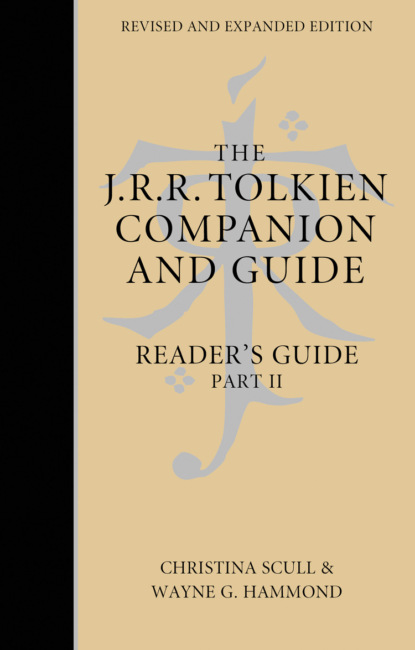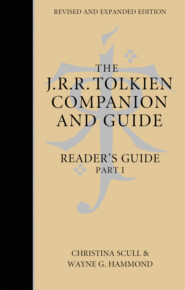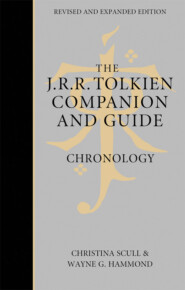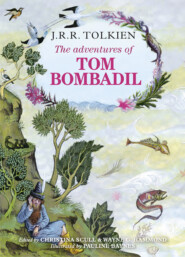По всем вопросам обращайтесь на: info@litportal.ru
(©) 2003-2024.
✖
The J. R. R. Tolkien Companion and Guide: Volume 3: Reader’s Guide PART 2
Настройки чтения
Размер шрифта
Высота строк
Поля
Personally I should be inclined to refuse to give any Bestätigung [confirmation] … and let a German translation go hang. In any case I should object strongly to any such declaration appearing in print. I do not regard the (probable) absence of all Jewish blood as necessarily honourable; and I have many Jewish friends, and should regret giving any colour to the notion that I subscribed to the wholly pernicious and unscientific race-doctrine. [Letters, p. 37]
With this he sent two possible replies, leaving it to Stanley Unwin to decide which to send to Germany. Only one remains in the Allen & Unwin archive, presumably the one not sent, possibly the more strongly worded of the two. In this Tolkien displays his knowledge of the correct use of the word Aryan as opposed to the Nazi misuse: ‘I regret I am not clear as to what you intend by arisch. I am not of Aryan extraction: that is Indo-iranian; as far as I am aware none of my ancestors spoke Hindustani, Persian, Gypsy, or any related dialects. But if I am to understand that you are enquiring whether I am of Jewish origin, I can only reply that I regret that I appear to have no ancestors of that gifted people’ (Letters, p. 37).
In 1944, in response to a comment made in a letter by his son *Christopher about apartheid in *South Africa, where he was training to be a pilot, Tolkien wrote on 18 April: ‘As for what you say or hint of “local” conditions: I knew of them. I don’t think they have much changed (even for the worse). I used to hear them discussed by my mother; and have ever since taken a special interest in that part of the world. The treatment of colour nearly always horrifies anyone going out from Britain & not only in South Africa. Unfort[unately] not many retain that generous sentiment for long’ (Letters, p. 73).
During the Second World War Tolkien wrote to Christopher on 23–25 September 1944, objecting to racist propaganda about the enemy:
I cannot understand the line taken by BBC (and papers, and so, I suppose, emanating from M[inistry] O[f] I[nformation]) that the German troops are a motley collection of sutlers and broken men …. The English pride themselves, or used to, on ‘sportsmanship’ (which included ‘giving the devil his due’) …. But it is distressing to see the press grovelling in the gutter as low as Goebbels in his prime, shrieking that any German commander who holds out in a desperate situation … is a drunkard, and a besotted fanatic.
It is clear that he considered revilement of the enemy, just because he was the enemy, as much an exhibition of racism as segregation or anti-Semitism – that patriotism did not justify racism. He continued in his letter that a recent article had called for the extermination of the German people because ‘they are rattlesnakes, and don’t know the difference between good and evil’. If one were to accept that idea, said Tolkien, then ‘the Germans have just as much right to declare the Poles and the Jews exterminable vermin, subhuman, as we have to select the Germans: in other words, no right, whatever they have done’ (Letters, p. 93).
Those who see evidence of racism in Tolkien’s works, whether conscious or unconscious, draw attention to descriptions which suggest that the various races of men that fought for Morgoth, Sauron, or Saruman (in *‘The Silmarillion’ or *The Lord of the Rings) are of Asian or African origin, while those on the ‘good’ side have European features. They also point to the existence of the race of Orcs, apparently irredeemably evil (*Good and Evil). Charles Moseley in J.R.R. Tolkien (1997) sums up some of the points:
Tolkien’s texts do reveal values that are Eurocentric, white, middle-class, patriarchal – those of the majority of his generation in England, in fact. They are values embedded in the very vocabulary of his work. The Black Speech of the Dark Tower … echoes the consonantal patterns of Turkish; the Orcs’ curved swords and their cruelty recall ancient legends, and illustrations, of the heathen East. The Southerners who come up the Greenway or fight in Mordor’s host are ugly, slant-eyed and swart, emblematic of a culturally embedded racial stereotype of evil, the enemy; while the forces ranged against them, so far as we can see, are clean-limbed, white, dark-haired, grey-eyed examples of Northern European excellence [p. 63]
Mosley does not mention Tolkien’s sympathetic treatment of Ghân-buri-Ghân and the Woses, but he does also point out that ‘no fiction can satisfy every orthodoxy, least of all those that are differently historically conditioned from those of its own time’ (p. 63).
Such critics tend to make no allowance for the fact that, although Tolkien meant Middle-earth to represent our world in fictional earlier ages, it is in fact a Secondary World which cannot be judged by events in our own particular history; that Tolkien as its author had the right to change the parameters; and that what he states as the truth is true within that world. Morgoth, Sauron, and Saruman, who seek to obtain dominion by force and fear, are indeed rebels against the Creator, Eru, and his vicegerents the Valar, and the Elves and Men who oppose them have learned the truth directly or indirectly from the Valar. Nor, indeed, do some critics note how many episodes in The Lord of the Rings plead for the abandonment of old prejudices, for tolerance and understanding, and show this being achieved through knowledge and greater appreciation of ‘the other’.
Virginia Luling in ‘An Anthropologist in Middle-earth’, in Proceedings of the J.R.R. Tolkien Centenary Conference 1992, ed. Patricia Reynolds and Glen H. GoodKnight (1995), notes that although Faramir’s explanation to Frodo that the lore of Gondor divides Men into ‘the High, or Men of the West, which were Númenóreans; and the Middle Peoples, Men of the Twilight, such as are the Rohirrim …; and the Wild, the Men of Darkness’ (The Lord of the Rings, bk. IV, ch. 5) may sound ‘like the classic Victorian evolutionary sequence of Savagery – Barbarism – Civilisation, which was around in Tolkien’s youth ….’ But on closer look,
the resemblance is only superficial; the whole structure of assumption underlying the two schemes is quite different. For the anthropology of Middle-earth is not evolutionary at all. The ‘high’ civilisations of Gondor and its predecessor Númenor have not developed by their own interior dynamic out of societies like that of the Rohirrim; they owe their arts and wisdom to their contact with the Elves …. The Rohirrim, too, owe their ‘twilight’ status to being descended from the Elf-friends of old. The ‘Men of Darkness’ are those who have not enjoyed the influence of the Elves ….
If we have something here that looks outwardly like what in our world we know as ‘racism’, we can dismiss that appearance, not only because Tolkien in his non-fictional writing several times repudiated racist ideas, but because … in his sub-creation the whole intellectual underpinning of racism is absent. The Haradrim and the Variags of Khand are corrupt not because they are biologically inferior but because they are human and therefore corruptible. In any case, though they are politically subject to Sauron it is uncertain … how far they are corrupt as individuals (unlike Orcs, who are a separate problem, and one that Tolkien himself never really solved). The men of Gondor and their allies are ‘nobler’, not by their intrinsic nature but because they have had the luck to inherit from their ancestors the mediated tradition – the faith – of Aman, and more or less held on to it – though they are constantly in danger of letting go. (As far as actual descent goes, they are ultimately the same as the Rohirrim.) [pp. 54–6]
Tolkien was writing out of the ‘leaf-mould’ of his own experience, and as he pointed out, ‘a man of the North-west of the Old World will set his heart and the action of his tale in an imaginary world of that air, and that situation: with the Shoreless Sea of his innumerable ancestors to the West, and the endless lands (out of which enemies mostly come) to the East’ (letter to *W.H. Auden, 7 June 1955, Letters, p. 212). The invaders who gained the most lasting reputation for savagery were the Huns, a warlike Asiatic nomadic people, who under Attila menaced both Constantinople and Rome. They suffered a major defeat in ad 451 at a battle on the Catalaunian plains, a recorded incident which may have influenced the depiction of Théoden’s death on the Pelennor Fields (see Reader’s Companion, p. 563). Europe also saw invasions by (among others) Arabs, whose drive into France was halted only at the Battle of Tours in ad 732, and who were not entirely expelled from Spain until 1492; Ottoman Turks, who took Constantinople in 1453, tried to take Malta in 1565, and besieged Vienna as late as 1683; and pirates from the north African coast and Turkey, who threatened ships in the Mediterranean and inspired the Corsairs of Umbar in The Lord of the Rings. This is not to say that the Europeans did not engage in internal conflict and in conquests of their own, but for them the invader from Asia or Africa was viewed with particular horror because he was an ‘infidel’.
Any discussion of racism and prejudice in Middle-earth is complicated by the fact that within those lands are not only several races of Men, but also other species – Elves, Dwarves, Hobbits, Ents, Drúedain (Woses), even Ainur – and the relations between these must also be considered. In ‘The Silmarillion’ a series of interspecies marriages are of great significance, obviously fated, and necessary to achieve the overthrow of Morgoth: those between Melian the Maia and Thingol the Elf, between their daughter Lúthien and the Man Beren, between the Man Tuor and the Elf Idril, and between their son Eärendil and Elwing, the granddaughter of Beren and Lúthien. Although many of the different species in Middle-earth do get on reasonably well, and sometimes are closely allied, very rarely do two species live together; but this seems to be by choice, not because of imposed segregation, with each species preferring to retain its own traditions and way of life. Even when two species do live in close contact, such as Men and Hobbits in Bree, this is still the case: ‘the Big and Little Folk (as they called one another) were on friendly terms, minding their own affairs in their own ways, but both rightly regarding themselves as necessary parts of the Bree-folk. Nowhere else in the world was this peculiar (but excellent) arrangement to be found’ (bk. I, ch. 9).
Slavery is always depicted by Tolkien as evil. Elves captured by Morgoth are forced to work, and some are perhaps corrupted and refashioned as Orcs; followers of Morgoth oppress and enslave the remnants of the People of Hador; in their decline, and under the influence of Sauron, the Númenóreans ‘came no longer as the bringers of gifts, but as men of war. And they hunted the men of Middle-earth and enslaved them and took their goods’ (*Sauron Defeated, p. 348); Sauron has many slaves to supply the needs of his armies in ‘the great slave-fields away south’ (The Lord of the Rings, bk. VI, ch. 2); and the Haradrim use captured men of Gondor to row their ships. Most of these examples of slavery are closer to that known in European history (the enslavement of the defeated by Greeks and Romans, or Irish or Viking raids on Britain for captives) than to ‘plantation’ slavery in the American South.
Rohan and Gondor do not enslave their defeated enemies. When the Rohirrim overwhelm Saruman’s army at Helm’s Deep, they disarm the hillmen of Dunland and tell them that if, after helping to bury the dead and repairing the damage Saruman’s army had done to Helm’s Deep, they are willing to take an oath never to attack Rohan again, they will be allowed to return, free, to their own land. ‘The Men of Dunland were amazed, for Saruman had told them that the men of Rohan were cruel and burned their captives alive’ (bk. III, ch. 8). At the end of the War of the Ring, Aragorn pronounces his judgement on those who have fought in Sauron’s armies and attacked the forces of the West: ‘And embassies came from many lands and peoples, from the East and the South, and from the borders of Mirkwood, and from Dunland in the West. And the King pardoned the Easterlings that had given themselves up, and sent them away free, and he made peace with the peoples of Harad; and the slaves of Mordor he released and gave to them all the lands about Lake Núrnen to be their own’ (bk. VI, ch. 5).
Since strife and open warfare are major elements in both ‘The Silmarillion’ and The Lord of the Rings, there is a certain amount of the nationalistic fervour expressed as hatred and even vilification of the opponent which Tolkien criticized in the letter he wrote to Christopher in September 1944. In Ithilien, both Mablung and Damrod curse the Southrons who are coming to reinforce Sauron’s armies. But this is balanced by Sam’s thoughts about the Southron killed in the ambush, seeing him as a person rather than an enemy: ‘He was glad he could not see the dead face. He wondered what the man’s name was and where he came from; and if he was really evil of heart, or what lies or threats had led him on the long march from his home; and if he would not really rather have stayed there in peace’ (bk. IV, ch. 4).
Tolkien rarely described the physical features of the enemy in any detail. The Swarthy Men or Easterlings who entered Beleriand after the Dagor Bragollach are said to be ‘short and broad, long and strong in the arm; their skins were swart or sallow, and their hair was dark as were their eyes’ (The Silmarillion, p. 157). A Mediterranean type was probably intended; some of these men betrayed their alliance with Maedhros, but others proved as faithful as the men of the Three Houses of the Edain. There are only a few brief descriptions of the men allied to Sauron in The Lord of the Rings: Gollum describes those about to enter the Morannon: ‘They have black eyes and long black hair, and gold rings in their ears …. And some have red paint on their cheeks’ (bk. IV, ch. 3). The fallen Southron seen by Sam had ‘black plaits braided with gold’, and his ‘brown hand still clutched the hilt of a broken sword’ (bk. IV, ch. 4). In the Battle of the Pelennor Fields the Southron chieftain wields a scimitar, which suggests a Saracen or Turk; and ‘out of Far Harad’ came ‘black men like half-trolls with white eyes and red tongues’ (bk. V, ch. 6). Since they come from the far South, these may be intended to suggest Africans, but as Virginia Luling points out, since Sauron’s armies were recruited mainly from the South and East it was natural that Tolkien should draw ‘on inherited images of “paynims” and other enemies’ (‘An Anthropologist in Middle-earth’, pp. 56–7), and it is only because they fight for Sauron that they are seen as enemies.
There are some examples of prejudice among Elves in The Silmarillion, but it always seems to suggest a character defect. The sons of Fëanor in their pride look down on the Elves who had remained in Middle-earth; Caranthir says to Angrod, in response to a message from Thingol, ‘Let not the sons of Finarfin run hither and thither with their tales to this Dark Elf in his caves!’ (The Silmarillion, p. 112); and later Curufin calls Eöl ‘Dark Elf’, and tells him that ‘those who steal the daughters of the Noldor and wed them without gift or leave do not gain kinship with their kin’ (pp. 135–6). When Thingol learns of the slaying of his kin at Alqualondë by some of the Noldor, he bans the use of the Noldorin tongue in his realm (*Languages, Invented).
Even within the small area of the Shire, there are prejudices among the Hobbits. Christina Scull wrote in ‘Open Minds, Closed Minds in The Lord of the Rings’, in Proceedings of the J.R.R. Tolkien Centenary Conference 1992, ed. Patricia Reynolds and Glen H. GoodKnight (1995): ‘The Hobbits were … doubtful about other Hobbits, not those of a different breed, but also those who lived in a different part of the Shire. In this Tolkien probably intended to reflect the attitudes of the inhabitants of the English countryside in the days before travel was common, when areas beyond the next village or market town were considered “foreign” and the people “different”’ (p. 151). While the Hobbits in the Ivy Bush
Вы ознакомились с фрагментом книги.
Приобретайте полный текст книги у нашего партнера:
Приобретайте полный текст книги у нашего партнера:








